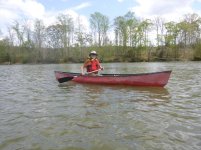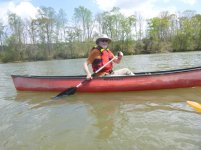Excellent research and information. Thanks for posting this! I'll be curious how you feel about the fit and performance after some real world paddling. I'm also curious how the extra flotation feels when in the water? I've often thought more flotation might make deep water re-entry easier.
Work and weather kept me from answering your question, but after a couple of paddles on flatwater and a Class 1-2 river and jumping into a pool in the river (it was up to 86 degrees today!) , I now have a few answers.
After testing the Force 6 Rescuer 3, I am very happy. Here are a few comments:
1. The PFD feels VERY heavy when you pick it up, but once it is on you do not even notice it. I was wondering if it would be too hot on a warm day, but after today's 4-hour trip down a wind tunnel of a river (10mph wind with gusts up to 21mph from downstream; if you stopped paddling you got pushed back upstream against a fast moving current) with constant paddling, I did got get too hot or feel the need to loosen the front zipper for venting.
2. The PFD did not interfere with any paddle strokes including off-side strokes. The chest padding is not as thick as, lets say, an Astral Green or Indus jacket, NRS Zen, or Stohlquist Descent. Since it is a waist-length PFD instead of a belly-length PFD designed for kayaking. I do not think the length would allow for use with a kayak, but it should work for a C1. Since it is longer, the foam floatation is distributed over a longer area.
3. I paddled both kneeling and sitting in open boats for my first tests and the PFD did great without binding when I twisted my body left and right. I was a bit concerned about the thickness of the padded shoulder straps when I tried it in the store, but it was not an issue while paddling. The back is thicker than most PFDs, so if you use a seat back it may not work; I plan on using this primarily as a whitewater PFD, so this is not an issue for me.
4. In the water- a slow pool instead of whitewater- I found this PFD to hold me noticeably higher than my old Lotus whitewater PFD or my Stohlquist Ebb. It did not inhibit my swimming any more than those two but seemed to have more drag as I swam. I did not try a re-entry, as I normally get to shore (with or without my canoe) when dumping in whitewater. I also have not tried a roll in my Millbrook Outrage with the Force 6 on. I need to work on that skill, it is probably pretty rusty.
5. If you need pockets, this isn't the best bet for you. It has 2 front slash pockets (My tiny Panasonic Lumix DMC-TS30 is a tight fit) but it has a huge area of MOLLE style straps on the front and back if you want to rig up a custom pocket system. Not having built in front pockets seems to keep the thickness to a minimum. I usually carry my extra stuff in a dry bag attached to the canoe anyway.
6. If you like low impact colors, too bad. This PFD only comes in bright red with bright yellow reflective patches on the shoulders. If you are washing down a rapid, you want to be seen.
That is what I found while testing the 26 pound of floatation PFD.


